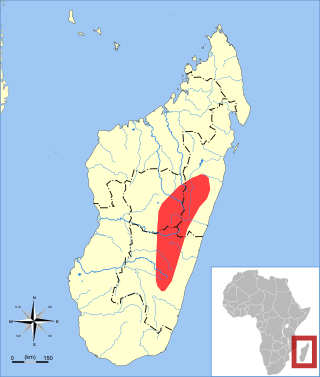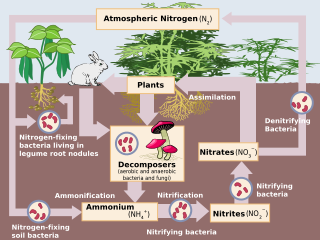
Tetrapods are four-limbed vertebrate animals constituting the superclass Tetrapoda. It includes extant and extinct amphibians, sauropsids and synapsids.
The aquatic ape hypothesis (AAH), also referred to as aquatic ape theory (AAT) or the waterside hypothesis of human evolution, postulates that the ancestors of modern humans took a divergent evolutionary pathway from the other great apes by becoming adapted to a more aquatic habitat.

Limnology is the study of inland aquatic ecosystems. The study of limnology includes aspects of the biological, chemical, physical, and geological characteristics of fresh and saline, natural and man-made bodies of water. This includes the study of lakes, reservoirs, ponds, rivers, springs, streams, wetlands, and groundwater. Water systems are often categorized as either running (lotic) or standing (lentic).

Aquatic plants are plants that have adapted to living in aquatic environments. They are also referred to as hydrophytes or macrophytes to distinguish them from algae and other microphytes. A macrophyte is a plant that grows in or near water and is either emergent, submergent, or floating. In lakes and rivers macrophytes provide cover for fish, substrate for aquatic invertebrates, produce oxygen, and act as food for some fish and wildlife.

A marsh is a wetland that is dominated by herbaceous rather than woody plant species. Marshes can often be found at the edges of lakes and streams, where they form a transition between the aquatic and terrestrial ecosystems. They are often dominated by grasses, rushes or reeds. If woody plants are present they tend to be low-growing shrubs, and the marsh is sometimes called a carr. This form of vegetation is what differentiates marshes from other types of wetland such as swamps, which are dominated by trees, and mires, which are wetlands that have accumulated deposits of acidic peat.

Energy flow is the flow of energy through living things within an ecosystem. All living organisms can be organized into producers and consumers, and those producers and consumers can further be organized into a food chain. Each of the levels within the food chain is a trophic level. In order to more efficiently show the quantity of organisms at each trophic level, these food chains are then organized into trophic pyramids. The arrows in the food chain show that the energy flow is unidirectional, with the head of an arrow indicating the direction of energy flow; energy is lost as heat at each step along the way.

The grass carp is a species of large herbivorous freshwater fish in the family Cyprinidae, native to the Pacific Far East, with a native range stretching from northern Vietnam to the Amur River on the Sino-Russian border. This Asian carp is the only species of the genus Ctenopharyngodon.

The Manchester Aquatics Centre, abbreviated MAC, is a public aquatics sports facility south of the city centre of Manchester, England, north of the main buildings of the University of Manchester near Manchester Metropolitan University. It was purpose built for the 2002 Commonwealth Games, and cost £32 million to build.

Amphizoa is a genus of aquatic beetles in the suborder Adephaga, placed in its own monogeneric family, Amphizoidae. There are five known species of Amphizoa, three in western North America and two in the eastern Palearctic. They are sometimes referred to by the common name troutstream beetles.

An aquatic ecosystem is an ecosystem formed by surrounding a body of water, in contrast to land-based terrestrial ecosystems. Aquatic ecosystems contain communities of organisms—aquatic life—that are dependent on each other and on their environment. The two main types of aquatic ecosystems are marine ecosystems and freshwater ecosystems. Freshwater ecosystems may be lentic ; lotic ; and wetlands.

The web-footed tenrec, Malagasy otter shrew, or aquatic tenrec is the only known semiaquatic tenrec, and is found in eastern Madagascar, especially in and around Ranomafana National Park. It grows to between 25 and 39 cm, and was once thought to be extinct. It feeds on crabs, aquatic insects, and crayfish. The population is considered vulnerable. It was formerly placed in the monotypic genus Limnogale, but has been moved to Microgale based on molecular data showing it to be deeply nested within the latter.

The Georgia Tech Campus Recreation Center is part of the Georgia Tech campus.

Terrestrial animals are animals that live predominantly or entirely on land, as compared with aquatic animals, which live predominantly or entirely in the water, and amphibians, which rely on a combination of aquatic and terrestrial habitats. Some groups of insects are terrestrial, such as ants, butterflies, earwigs, cockroaches, grasshoppers and many others, while other groups are partially aquatic, such as mosquitoes and dragonflies, which pass their larval stages in water. Terrestrial animals tend to be more developed and intelligent than aquatic animals.

Whippomorpha or Cetancodonta is a group of animals that contains all living cetaceans and hippopotamuses, as well as their extinct relatives, i.e. Entelodonts and Andrewsarchus. All Whippomorphs are descendants of the last common ancestor of Hippopotamus amphibius and Tursiops truncatus. This makes it a crown group. Whippomorpha is a suborder within the order Artiodactyla. The placement of Whippomorpha within Artiodactyla is a matter of some contention, as hippopotamuses were previously considered to be more closely related to Suidae (pigs) and Tayassuidae (peccaries). Most contemporary scientific phylogenetic and morphological research studies link hippopotamuses with cetaceans, and genetic evidence has overwhelmingly supported an evolutionary relationship between Hippopotamidae and Cetacea. Modern Whippomorphs all share a number of behavioural and physiological traits; such as a dense layer of subcutaneous fat and largely hairless bodies. They exhibit amphibious and aquatic behaviors and possess similar auditory structures.

Human impact on the nitrogen cycle is diverse. Agricultural and industrial nitrogen (N) inputs to the environment currently exceed inputs from natural N fixation. As a consequence of anthropogenic inputs, the global nitrogen cycle (Fig. 1) has been significantly altered over the past century. Global atmospheric nitrous oxide (N2O) mole fractions have increased from a pre-industrial value of ~270 nmol/mol to ~319 nmol/mol in 2005. Human activities account for over one-third of N2O emissions, most of which are due to the agricultural sector. This article is intended to give a brief review of the history of anthropogenic N inputs, and reported impacts of nitrogen inputs on selected terrestrial and aquatic ecosystems.
Vladimir Vasilevich Pyshnenko is a Russian former freestyle swimmer who won one gold medal and two silver medals at the 1992 Summer Olympics at Barcelona and one silver medal at the 1996 Summer Olympics at Atlanta. He also won two silver medals at the 1994 World Aquatics Championships in Rome and one gold medal at the European LC Championships 1991.

Prionosuchus is an extinct genus of large temnospondyl. A single species P. plummeri, is recognized from the Early Permian. Its fossils have been found in what is now northeastern Brazil.
Landscape limnology is the spatially explicit study of lakes, streams, and wetlands as they interact with freshwater, terrestrial, and human landscapes to determine the effects of pattern on ecosystem processes across temporal and spatial scales. Limnology is the study of inland water bodies inclusive of rivers, lakes, and wetlands; landscape limnology seeks to integrate all of these ecosystem types.

Hypoxia refers to low oxygen conditions. Normally, 20.9% of the gas in the atmosphere is oxygen. The partial pressure of oxygen in the atmosphere is 20.9% of the total barometric pressure. In water, oxygen levels are much lower, approximately 7 ppm or 0.0007% in good quality water, and fluctuate locally depending on the presence of photosynthetic organisms and relative distance to the surface.
Narayana Balakrishnan Nair (1927–2010) was a marine biologist, ecologist and the founder president of Kerala Science Congress. He was known for his advocacy of trawling ban during monsoon seasons which was later accepted and imposed by the Government of Kerala. A Jawaharlal Nehru fellow, Nair was an elected fellow of all the major Indian science academies as well as the Zoological Society of London. The Council of Scientific and Industrial Research, the apex agency of the Government of India for scientific research, awarded him the Shanti Swarup Bhatnagar Prize for Science and Technology, one of the highest Indian science awards, in 1971, for his contributions to biological sciences. He received the fourth highest Indian civilian honor of the Padma Shri in 1984.
















